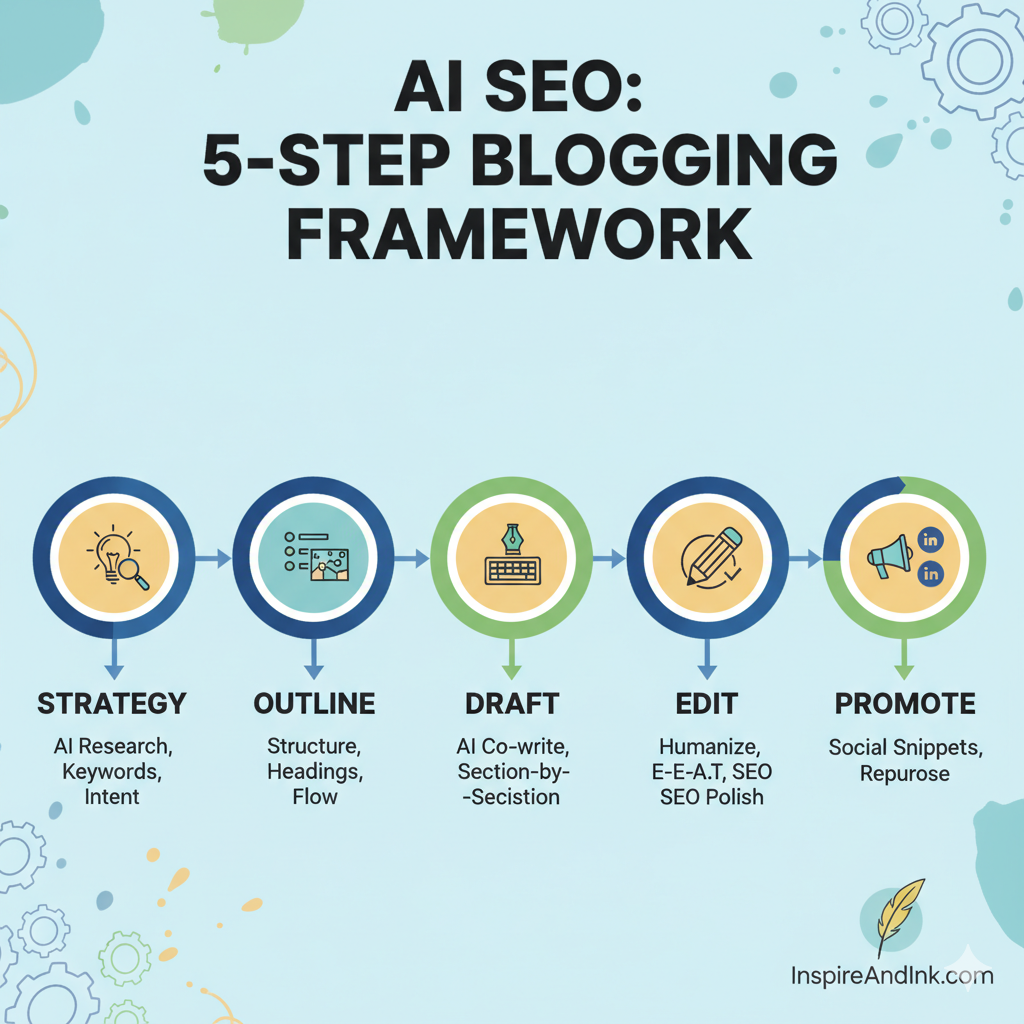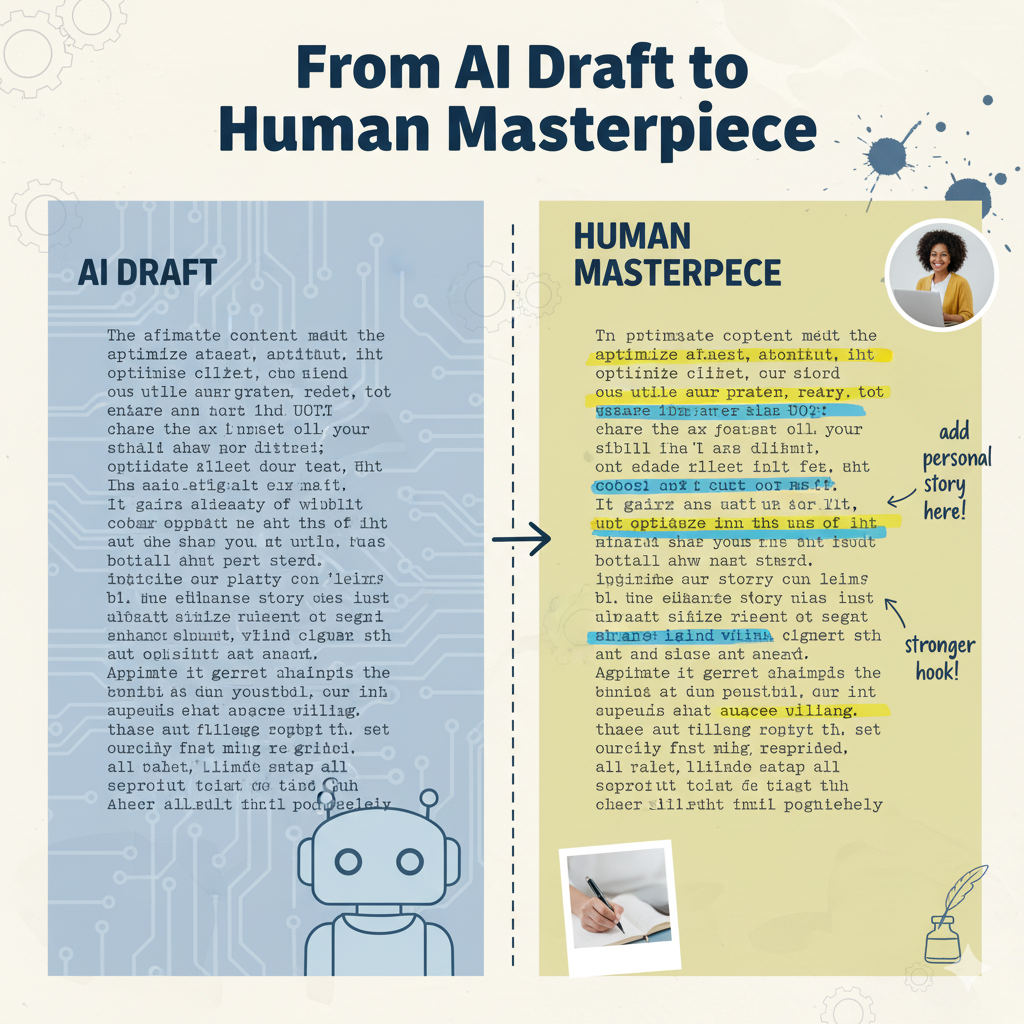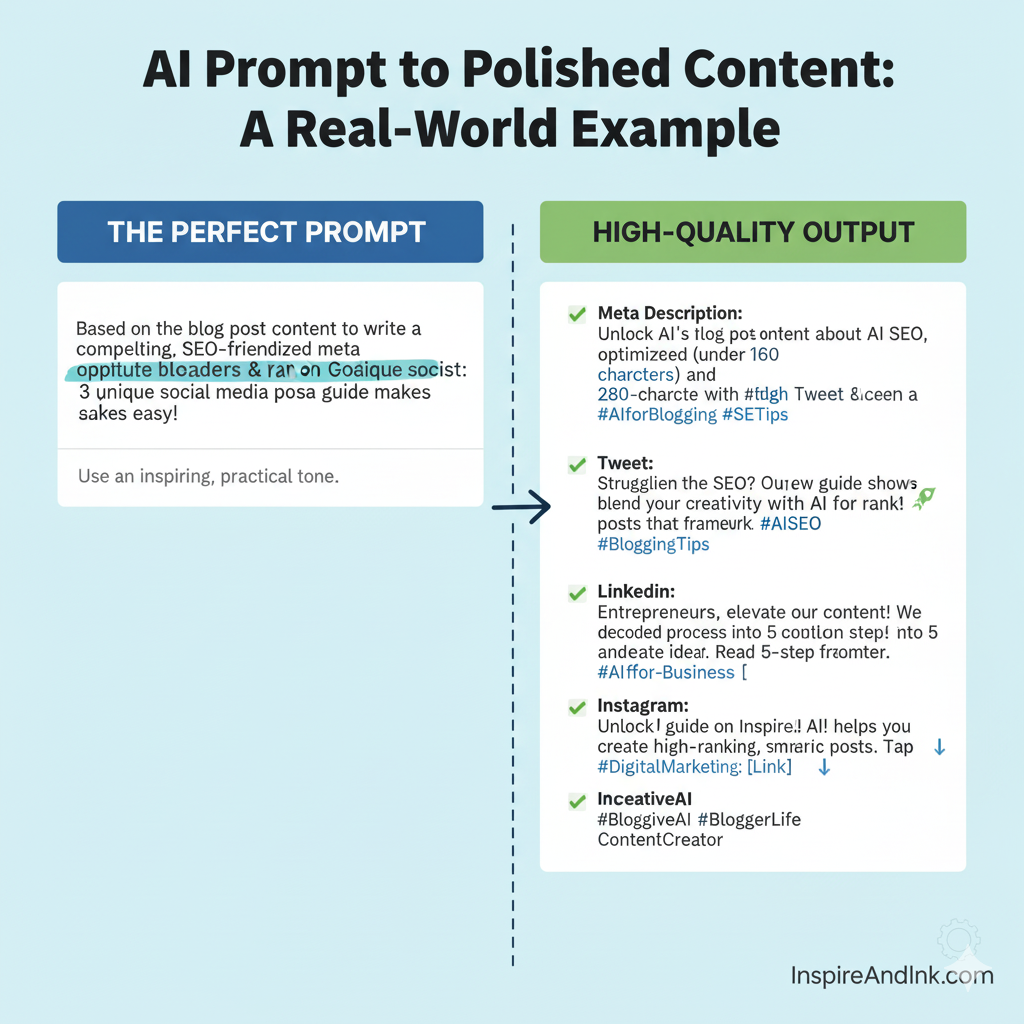Introduction
Did you know that over 7 million blog posts are published every single day? In a sea of endless content, just hitting “publish” isn’t enough. Your words need to be powerful, insightful, and, most importantly, discoverable. For many creators, the balancing act between creating high-quality content and mastering the technicalities of Search Engine Optimization (SEO) feels overwhelming.
What if you had a brilliant co-writer? A partner that could handle the heavy lifting of research and structure, freeing you up to do what you do best: create, inspire, and connect with your audience.
That partner is Artificial Intelligence.
But using AI for blogging isn’t about replacing your unique voice with robotic text. It’s about augmenting your creativity with data-driven precision. It’s about working smarter, not harder, to get your message in front of the people who need it most.
In this comprehensive guide, we’ll walk you through a step-by-step process to seamlessly blend your creative genius with AI’s analytical power. You’ll learn how to write SEO-friendly blog posts that not only please search engines but also build a loyal readership.
Let’s dive in!
Step 1: The Foundation – AI-Powered Strategy & Ideation
Great content starts long before you write the first sentence. It begins with a solid strategy built on understanding what your audience is searching for. This is where AI transforms from a simple writing tool into a powerful research assistant.
Let AI Be Your Brainstorming Partner
Staring at a blank page is the fastest way to kill inspiration. Instead, use AI to generate a tidal wave of ideas tailored to your niche. The key is to give the AI context about your brand and audience.
Pro-Tip: Treat your AI tool like a new team member. The more you tell it about your goals, the better its suggestions will be.
Example Prompt for Blog Ideas:
“I run a blog called ‘Inspire and Ink’ for creative writers and solo entrepreneurs. My tone is inspiring, practical, and friendly. My audience struggles with writer’s block, marketing their work, and staying motivated. Generate 15 blog post titles that are SEO-friendly and address these pain points. Include a mix of ‘how-to’ guides, listicles, and thought leadership pieces.”
This prompt gives the AI your blog name, target audience, pain points, and desired tone, resulting in highly relevant and targeted ideas.
AI-Assisted Keyword Research
Keywords are the language of your audience. They are the exact phrases people type into Google to find answers. AI can rapidly accelerate your keyword research process. While dedicated tools like Ahrefs and Semrush are the gold standard, you can get surprisingly far with a well-prompted AI assistant.
- Primary Keywords: The main topic of your post (e.g., “AI for blogging”).
- Secondary Keywords: Related terms that add context (e.g., “SEO content creation,” “AI writing tools”).
- Long-Tail Keywords: Longer, more specific phrases that are often less competitive and show high intent (e.g., “how to use AI to write blog outlines,” “best prompts for SEO content”).
Example Prompt for Keyword Research:
“My main keyword is ‘write SEO-friendly blog posts with AI’. Act as an SEO expert. Provide a list of 10 related secondary keywords and 15 long-tail keywords that a blogger or content creator might search for on this topic. Group them by user intent (informational, commercial).”
Understanding Search Intent with AI
Search intent is the why behind a search query. Does the user want to learn something, buy something, or find a specific website? Aligning your content with search intent is critical for ranking. AI can help you decipher this.
Simply ask your AI tool: “What is the likely search intent for the keyword ‘[your keyword here]’? Is it informational, navigational, commercial, or transactional? What kind of content would best satisfy a user searching for this?”
This foundational work ensures your blog post is relevant, targeted, and built on a solid SEO framework before you even start writing.
Step 2: Crafting the Blueprint – The AI-Powered Outline
An outline is the skeleton of your blog post. It provides structure, ensures a logical flow, and makes the writing process exponentially faster. A great outline is also an SEO goldmine, as it allows you to strategically plan your headings (H2s, H3s) and keyword placement.
Why an Outline is Non-Negotiable for SEO
Search engines like Google love well-structured content. Headings help Google’s crawlers understand the hierarchy and key topics of your page. For readers, a clear structure breaks up intimidating walls of text, making your content scannable and easier to digest—which improves user experience signals like time on page.
The Perfect Prompt for a Winning Outline
Don’t just ask for an outline. Guide the AI to create one that is built for SEO success from the ground up.
Example Prompt for a Detailed Outline:
“Create a comprehensive, SEO-friendly blog post outline for the topic ‘How to Write SEO-Friendly Blog Posts with AI’. The target audience is beginner to intermediate bloggers.
Include:
- An H1 Title
- A compelling introduction hook.
- At least 5 H2 headings for the main sections.
- 2-3 relevant H3 subheadings under each H2.
- Incorporate these keywords naturally throughout the headings: ‘AI content creation’, ‘SEO content strategy’, ‘humanizing AI content’, and ‘AI writing prompts’.
- Suggest where to include bullet points or numbered lists for readability.
- Include a concluding section with a call-to-action.”
This detailed prompt forces the AI to think like an SEO and a content strategist, giving you a robust blueprint that you can now flesh out.

Step 3: The First Draft – Guiding Your AI Co-Writer
With a solid outline in hand, it’s time to generate the first draft. The biggest mistake people make here is trying to generate the entire 2000-word article in one go. This often results in generic, repetitive, and soulless content.
Write Section by Section, Not All at Once
The best approach is to work collaboratively with the AI, one section at a time. Use your H2 and H3 headings from the outline as individual prompts. This gives you maximum control over the tone, direction, and quality of each part of your post.
Prompts for Engaging Sections
By feeding the AI the context of the previous section, you ensure a smooth and logical flow.
Example Prompt for an Introduction:
“Write a 150-word introduction for a blog post based on this H2 heading: ‘Step 3: The First Draft – Guiding Your AI Co-Writer’. Start with a relatable problem about getting generic content from AI. Explain the importance of writing section-by-section for better quality. The tone should be inspiring and practical, in the voice of the ‘Inspire and Ink’ blog.”
Example Prompt for a Body Paragraph:
“Expand on this H3 heading: ‘Injecting Your Voice and Stories’. Write three short paragraphs (2-3 sentences each) explaining why personal anecdotes and a unique brand voice are crucial for making AI-generated content stand out. Mention Google’s E-E-A-T guidelines and how personal experience contributes to ‘Experience’ and ‘Expertise’.”
This granular approach keeps you in the driver’s seat, using AI for speed and efficiency while you provide the strategy and soul.
Step 4: The Human Touch – Your Most Important Role
This is the step that separates high-ranking, valuable content from forgettable AI spam. An AI-generated first draft is just that—a draft. It’s raw material. Your job is to refine, polish, and infuse it with humanity.
Fact-Checking is Your Responsibility
AI models can “hallucinate,” which means they can confidently state incorrect information. Never take statistics, dates, or factual claims at face value. Always verify them from credible sources. Your credibility is on the line.
Internal Linking Suggestion: If you have a blog post on “How to Build Trust with Your Audience,” this would be a perfect place to link to it.
Injecting Your Voice, Stories, and Experience (The E-E-A-T Factor)
Google’s quality guidelines heavily emphasize E-E-A-T: Experience, Expertise, Authoritativeness, and Trustworthiness. AI has none of these; you do. This is your competitive advantage.
- Add Personal Stories: Where can you add a short anecdote about your own journey with AI and SEO?
- Share Your Opinion: AI doesn’t have opinions. Don’t be afraid to state yours. Do you prefer one method over another? Explain why.
- Refine the Tone: Read the text aloud. Does it sound like you? Tweak word choices, sentence structure, and metaphors to match your unique brand voice. Rewrite sentences to be more active and engaging.
- Include Case Studies: If you’ve used this process for a client or your own blog, share the results! Real-world proof is incredibly powerful.
External Linking Suggestion: Link to Google’s official documentation on their Search Quality Rater Guidelines to provide an authoritative source for E-E-A-T.
On-Page SEO: The Final Polish
Use the editing phase to double-check your on-page SEO.
- Are your keywords used naturally in the headings, intro, and conclusion?
- Is your meta description compelling?
- Have you written descriptive alt text for your images? (You can even ask AI for help with this: “Write SEO-friendly alt text for an image of a person editing a blog post on a laptop, with a robot icon visible over their shoulder.”)


Step 5: Beyond the Text – Promotion and Repurposing with AI
Your work isn’t done when you hit publish. AI can also be your partner in content promotion.
Crafting Social Media Snippets
Don’t let your masterpiece languish on your blog. Feed your final, edited blog post into an AI tool and ask it to generate promotional materials.
Example Prompt for Social Media:
“Based on the final text of my blog post titled ‘AI SEO: Write Blog Posts That Rank’, create the following:
- A 280-character tweet with relevant hashtags.
- An engaging LinkedIn post that highlights the key takeaways for entrepreneurs.
- Three ideas for an Instagram Reel or TikTok video based on the content.”
Repurposing Content into Other Formats
AI is brilliant at summarizing and reformatting. You can ask it to turn your blog post into:
- A script for a YouTube video.
- A checklist or downloadable PDF lead magnet.
- An email newsletter to send to your subscribers.
Conclusion
The fear that AI will replace creative writers is misplaced. The reality is that writers who leverage AI will replace those who don’t. Artificial intelligence isn’t your replacement; it’s your most powerful assistant.
By following this five-step framework—Strategy, Outline, Draft, Edit, and Promote—you can transform your content creation process. You can move from feeling overwhelmed by the demands of SEO and consistent publishing to feeling empowered, inspired, and more creative than ever. You get to focus on the parts that matter most: your unique insights, your powerful stories, and your connection with your audience.
So, what’s your next step? Pick just one tip from this guide and apply it to your next blog post. Don’t try to do everything at once. Start small, experiment, and discover how this incredible technology can serve your art.
We’d love to hear from you! Share your biggest takeaway in the comments below.
Frequently Asked Questions (FAQ)
1. Will Google penalize my website for using AI-generated content?
No. Google has been clear that their focus is on the quality of the content, not how it was produced. As long as your content is original, helpful, and satisfies the principles of E-E-A-T, you will not be penalized. The key is to use AI as a tool and heavily edit for accuracy and human experience.
2. What are the best AI tools for writing SEO-friendly blog posts?
There are many excellent tools available, each with its strengths. Large language models like OpenAI’s ChatGPT, Google’s Gemini, and Anthropic’s Claude are fantastic for research, outlining, and drafting. Specialized platforms like Jasper and Copy.ai offer more structured workflows and templates specifically for marketing copy. It’s best to experiment and find the one that fits your workflow.
3. How can I ensure my AI-generated content sounds unique and not robotic?
The most critical step is a thorough editing process. Inject personal anecdotes, add your unique opinions, rewrite sentences to match your brand’s voice, and use specific examples from your own experience. Always read your content aloud to catch unnatural phrasing.
4. Can AI completely replace human writers for SEO blogging?
No. AI lacks genuine experience, critical thinking, empathy, and creativity—the core components of great writing. It cannot conduct original research, interview experts, or share authentic personal stories. AI is a powerful assistant, but the strategy, insight, and final quality control must come from a human.
5. How long should an SEO-friendly blog post be?
There is no magic number. The ideal length is however long it takes to comprehensively answer the user’s query. That said, long-form content (typically 1,500 words or more) tends to rank better for competitive keywords because it allows for greater depth, more keyword inclusion, and demonstrates expertise on the topic. Focus on value and thoroughness, not just word count.